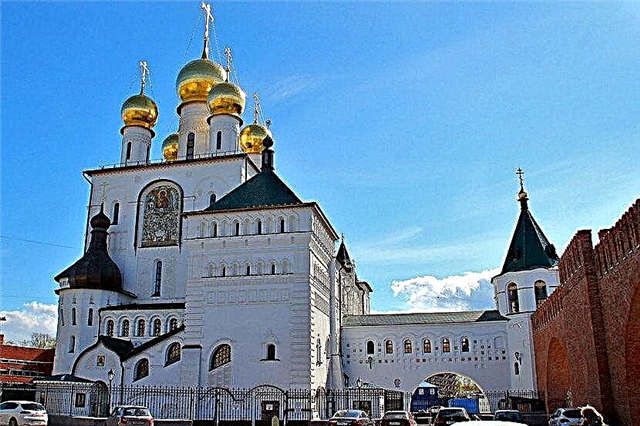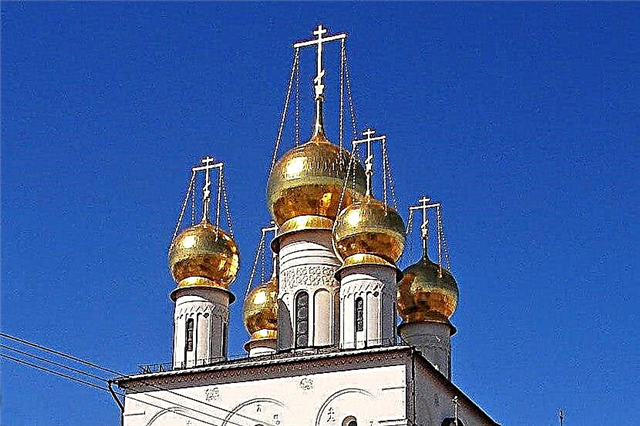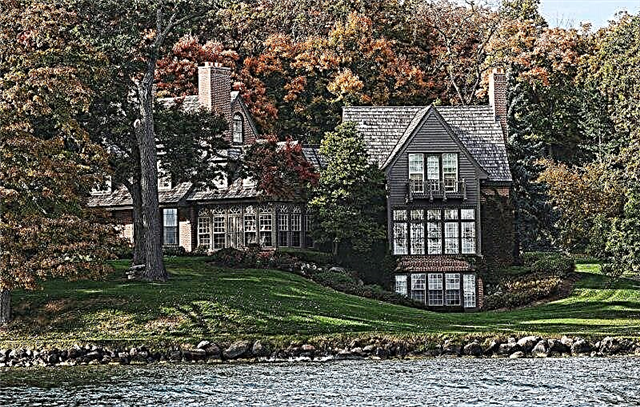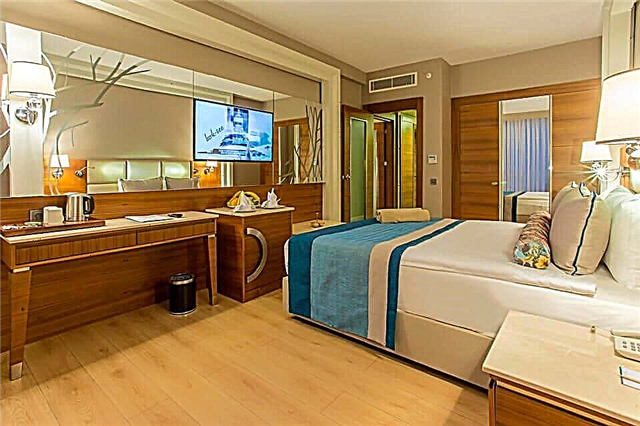Address: Russia, Saint Petersburg, Mirgorodskaya street
Building: 1911 - 1914
Project author: Stepan Samoilovich Krichinsky
Coordinates: 59 ° 55'32.8 "N 30 ° 22'07.1" E
Object of cultural heritage of the peoples of the Russian Federation
Content:
The original church complex near the Moskovsky railway station is considered one of the most beautiful cathedrals and churches in St. Petersburg. Residents of the city call it the Romanov Church, because the temple appeared in the year of the 300th anniversary of the Romanov dynasty. In the 20th century, the cathedral went through difficult trials. Today the architectural monument has been completely restored and is open to pilgrims and tourists.

Fedorovsky Cathedral from a bird's eye view
Temple history
At the beginning of the last century, several years before the significant date, preparations began in Russia for the celebration of the anniversary of the reigning dynasty. The city authorities of St. Petersburg decided to build a new church, which would look like the most beautiful pre-Petrine churches in the Upper Volga region.
In 1909, the younger brother of Tsar Nicholas II, Grand Duke Mikhail Alexandrovich Romanov, became the patron saint of the construction committee. The project of the church was prepared by a talented Russian architect, master of eclecticism Stepan Samoilovich Krichinsky. The organizers found a suitable place near the Nikolaevsky railway station, on the territory of the courtyard of the Fedorov male monastery, and collected 500 thousand rubles for the future construction.
In the summer of 1911, a solemn foundation-laying ceremony was held in the city. Distinguished guests from the government and priests lowered old coins into the prepared pit, and the Grand Duke Mikhail Alexandrovich put several rare coins of the early 17th century there.

View of Fyodorovsky Cathedral from Poltava Passage
The construction proceeded quickly - after 2.5 years, a rite of consecration was held in the Romanov Church. The celebration turned out to be magnificent and crowded. It was attended by the emperor, his daughters, the mother of Nicholas II - Maria Feodorovna, Princess Elizabeth Feodorovna, several ministers and the chairman of the State Duma.
The new cathedral began to play the role of a monastery courtyard and at the same time was a parish church for the employees of the Nikolaev station. His status was very high. Before the revolution, an archimandrite and 11 priests lived at the temple.
After the coming of the new government, in January 1918, the cathedral ceased to be a courtyard of the monastery and remained only the parish church of the station. For several years, a Sunday school was maintained here, in which children learned to read and write. The country was seething with transformation, and negative changes were inevitable.
Several times they wanted to close the Romanov Church, and give the building to a railway club or cinema. The abbot, Archimandrite Dosifei, opposed this as much as he could. To preserve the shrine, he was forced to transfer the management of the church to the community of renovation believers who supported the Soviet regime.

View of the Fedorovsky Cathedral from Mirgorodskaya street. On the left is the church-chapel of the New Martyrs and Confessors of Russia
Divine services in the cathedral continued until the early 1930s. When the country launched an active campaign against the church, the temple was closed, and the building began to be used for a dairy plant. Under the vaults of the cathedral, where people used to pray, dairy products were processed and packaged. To prevent the domes from spoiling the view of the new industrial world, they were simply demolished.
The former temple looked lonely and quickly overgrown with ugly outbuildings. Only high, decapitated drums reminded of the former greatness. In the 1970s, the USSR received US President Richard Nixon. Before the arrival of the leader of a foreign state to Leningrad, the city began to be put in order. The authorities decided that the temple drums spoiled the appearance of the building, and they were hastily demolished.
In 1993, it was decided to move the dairy production to a new location and return the temple to the faithful. The dairy plant occupied the church for 73 years, and the Orthodox community received the building only in 2005. The restoration took several years. It was completed in 2013, to mark the 100th anniversary of the construction of the Romanov Church.

View of the northern facade of the Feodorovsky Cathedral
Fedorovskaya icon
The cathedral is dedicated to one of the most revered images in Russia - the Fedorov Icon. According to legend, the author of the image of the Virgin with little Jesus in her arms was the evangelist Luke. This icon appeared in Russia in the 12th century, and a wooden chapel was built for it in Gorodets. A century later, the male Mother of God-Fedorovskaya monastery grew up here.
The famous icon received its name in honor of the holy great martyr Theodore Stratilates. It was considered hardly the main shrine of the Romanov family. It was with this icon that the founder of the dynasty, Mikhail Romanov, was called to the kingdom in 1613. Currently, the ancient shrine is kept in the Epiphany Cathedral in the city of Kostroma.

Architectural features
The intricate building of the Fedorovsky Cathedral was erected in the neo-Russian style, modeled on the Orthodox churches of Rostov the Great, Yuryev-Polsky, Suzdal and Yaroslavl, which were built during the reign of Tsar Mikhail Fedorovich. St. Petersburg Cathedral is made of reinforced concrete and stands on a solid reinforced concrete slab. Its domes glow with a pleasant gilding.
The unusual temple combines ancient motifs with Art Nouveau, has a height of 48 m and can accommodate 3.5 thousand believers. Three towers, unlike each other, rise along the perimeter of the building. The walls are lined with white limestone and decorated with intricate carvings. On them it is easy to find the bird of paradise Sirin, the Russian two-headed eagle, the Phoenix bird, a lion and a unicorn.
A mosaic depicting the Mother of God, Russian saints and representatives of the Romanov dynasty flaunts on the front facade on the north side. It is made of majolica and is 8 m high.

The main entrance to the cathedral is decorated with a mosaic icon of Jesus Christ. More than a hundred years ago, the masters of the Academy of Arts made an unusual icon based on a drawing by Vasily Mikhailovich Vasnetsov. Unfortunately, during the years of Soviet power, the original mosaic image was destroyed. Only a few scattered fragments have survived under a thick layer of plaster. The modern mosaic artist Viktor Tatarenko used them as a model and recreated the beautiful mosaic from scratch.
A covered walkway, which looks like the red-brick wall of the Moscow Kremlin, connects the main building with a slender hipped bell tower. Everyone who walks from the Moscow railway station sees a neat tiled roof on the octahedral dome. 11 bells hang in the openings of the bell tower, the total weight of which is 17 tons.

Interiors and shrines
There are two temples inside the building, and they differ in their design. The lower throne was consecrated in honor of Prince Alexander Nevsky and Mary Magdalene - the heavenly patrons of the Russian Tsar Alexander III and his wife. According to the project, the lower temple should be decorated in the tradition of the Novgorod churches of the 13th century, but the plan was never realized.
Today, the lower part of the cathedral is decorated with frescoes painted by the modern icon painter Archimandrite Zinon. The delicate colors of the paintings are harmoniously combined with the stone decor elements.
The interiors of the upper church are reminiscent of churches from the first half of the 17th century. The upper part of the cathedral has been completely restored and looks like at the beginning of the last century. Inside the high and light church, there is a five-tiered carved iconostasis, and a huge bronze chandelier hangs in the center.

Cathedral domes
The marble floor is decorated with a round two-tone rosette. Many elements of the decoration of the Fyodorovsky Cathedral are exact copies of the liturgical utensils of the 17th-18th centuries, which are kept in the Armory Chamber of Moscow.
Temple of the New Martyrs
The return of the cathedral to the Church took several years. So that believers could attend services, in 1992 a temporary chapel was built next to the disfigured building of the temple. After 6 years it was dedicated to the New Martyrs and Confessors of Russia.Today the small church has a beautiful four-row iconostasis. Almost all the icons that are here were painted especially for this temple.
Useful information for visitors
Pilgrims and tourists can enter the cathedral any day from 6:30 am to 7:00 pm. The entrance is free. Services are held daily in the morning and in the evening.

View of the panel "The Vyshny Protection of the Mother of God over the Reigning House" on the northern facade of the cathedral
Great educational work is being done in the cathedral. The church has a Sunday school for children and adults, an excursion service and a school of biblical philology, whose listeners learn the languages of the Holy Scriptures. Religious courses are open here, lectures on art history and history, concerts of classical and sacred music are held.
How to get there
The cathedral stands in the center of the city, on Mirgorodskaya street. It is convenient to walk to it from the metro stations "Ploschad Vosstaniya" and "Ploschad Aleksandr Nevsky".











